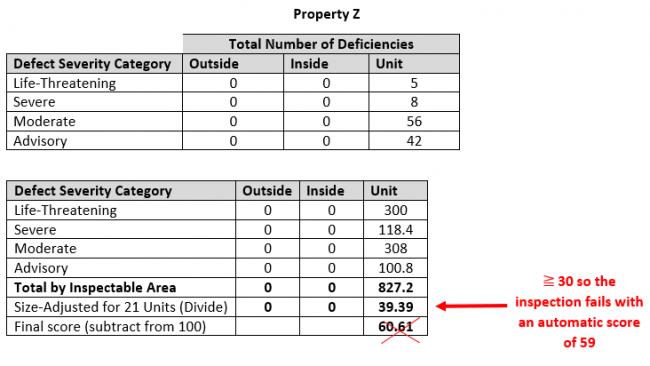In this March 2023 issue of our HUD-REAC/UPCS/NSPIRE Monthly Newsletter, I am pleased to announce that HUD has finally released the preliminary scoring notice for NSPIRE which you can read here: NSPIRE Scoring Notice! It is “preliminary” because it has not yet been posted to the Federal Register for public comment. Once it does post, you only have 30 DAYS to provide your feedback to HUD! I will send out a quick news alert to all of you when this happens.
Although the scoring is MUCH easier to understand than REAC ever was, I have some serious concerns about NSPIRE’s scoring implementation on HUD-Assisted properties.
SCORING RULES
- Each deficiency will be assigned one of the following designations (No more Level 1, 2 or 3):
- Life-Threatening Health & Safety
- Severe (Non-Life-Threatening) H&S
- Moderate H&S
- Advisory (not a Health & Safety)
- Each of those designations will be assigned a Weight (see table)

- To get your “Total Defect Points” you would multiply how many deficiencies of each designation then add them together. For instance, if you have 2 Unit LT’s and 3 Inside Severe:
2×60 = 120 Unit LT and 3×13.4 = 40.2 Inside Severe. Then add them together to get Total Defect Points 120+40.2 = 160.2
- Then you will divide the Total Defect Points by how many units you inspected. This is called “Size-Adjusting.” So if we inspected 15 units, 160.2/15 = 10.68 Total Size-Adjusted Defect Points
- Now all you do is subtract the Total Size-Adjusted Defect points from 100 and voila…you get your score. In our example, it’s 89.32 (89 after rounding).
There is one major catch. For Units, you cannot have 30 or more Total Size-Adjusted Defect Points and pass the inspection. HUD will give you an automatic score of 59 for the inspection regardless of the math (see example below for Property Z).
I used actual REAC inspection reports to see how the new NSPIRE scoring would affect them.
Property X has 1 building and 196 units. 24 Units were inspected, and they scored a 78 on the REAC. As you can clearly see, this property had no deficiencies in Common Areas, Exterior or Site.

Not a huge difference going from a REAC score of 78 to a NSPIRE score of 73.4. Let’s take a look at one more example:
Property Z has 22 Buildings and 97 Units. 21 Units were inspected and they scored a 70 on their REAC inspection.

The reason for the drastic score plummet on this inspection is twofold. First, REAC inspections do not score duplicate deficiencies in the same inspectable area. If you have 18 trip hazards on the Site, only the first trip hazard scores…the rest are observations. Under NSPIRE, ALL of the trip hazards would be counted for scoring purposes. In the case of Property Z, duplicate deficiencies that were not scored in the Units were now individually counted for NSPIRE.
Second, numerous REAC Unit deficiencies that were very low scoring under REAC are now much more heavily weighted in NSPIRE. For example, the peeling paint on a wall or ceiling that cost the property 0.01 is now, because the property was built in 1972, either a Moderate H&S for under 2 square feet of peeling paint or a Severe H&S for above 2 square feet. There is nothing written in the Standards as to whether pre-1978 properties will get a waiver on this defect if they produce a Lead Based Paint inspection report.
New Sample Size Chart
Click here to see the current HUD-REAC Sample Size Chart. NSPIRE will be adding more Sample Units to the inspection depending on the size of your property.

NSPIRE and the Public Housing Assessment System (PHAS)
- The Physical Assessment Sub-System (PASS) indicator is worth 40 points of the PHAS score. NSPIRE scores will be used to calculate the PASS indicator only after all the properties in the public housing agencies (PHA) portfolio have been inspected under NSPIRE. Until then, the PASS indicator will be based on UPCS (REAC) scoring.
Good News about NSPIRE Scoring
- Smoke alarms/detectors and Carbon Monoxide alarms/detectors will continue to be non-scoring 24-hour repairs under NSPIRE just like it is with REAC inspections. Smoke alarms will continue to be reflected in the score with an * (asterisk), the symbol to be used for CO alarms/detectors is to be determined.
- Brand new deficiencies will not be scored for “at least the first year” from the effective date of the Final NSPIRE Rule in order to allow properties to adequately prepare and comply with them. These are called Affirmative Requirements and the list of these will be included in the Final Rule but are expected to include the following:
- GFCI protected outlets within 6 feet of a water source
- Guardrails for elevated walkways
- Permanently installed heating source for certain climate zones
- Permanently mounted light fixture in the kitchen and each bathroom
- Although the new Affirmative Requirements will not be scored in “at least the first year,” HUD will provide 2 scores on the inspection report; one that shows the potential score if all new affirmative requirements were scored, and the official score for that inspection.
- HUD will be providing letter grades from A to F where an A would mean you scored 90 or more, E is above a 30 but less than 60, and an F would be 30 or less.
- HUD realizes that 24 hours or 30 days to repair certain defects would be difficult to achieve so they are considering allowing the defect to “remain open” with communication from the property on the process of remediation. More info on this will be posted in the NSPIRE Administrative notice.
- Not all buildings at a property will be inspected. Only those buildings that contain Sample units will be inspected.
- How many buildings a property has will not affect the score like it does with REAC inspections.
Potentially Negative news about NSPIRE scoring…HUD Needs Feedback!
- Under NSPIRE, there are no score caps.
- For instance, under REAC, if each Unit was capped at 2 points and the inspector recorded 20 Level 3’s in that unit…the Unit would only cost the property 2 points (you could not go negative).
- Under REAC, if you had just 1 building – it didn’t matter if you had 1 painted sprinkler head or 50 painted sprinkler heads…you would cap out at 10 points.
- Under NSPIRE, duplicate deficiencies are scored.
- Under REAC, if I record 5 door hardware defects in a Unit – only the Level 3 (highest level) would score…the other 4 defects would be observations only. Whereas with NSPIRE, ALL 5 DEFECTS will be scored.
- Under REAC, if you had 18 trip hazards on the Site – only the first trip hazard scored the rest were considered observations. Whereas with NSPIRE, ALL 18 TRIP HAZARDS will be scored!
- Under NSPIRE, many deficiencies that were not scored or extremely low-scoring in REAC are now much higher-scoring. A few examples:
- Trip hazards in Units and Common areas were not scored under REAC, but with NSPIRE they are considered “Moderate Health & Safeties” (see chart for impact weight measurement)
- Call-For-Aids in Units were worth approximately 0.1 points under REAC, but with NSPIRE they are considered “Severe” or “Life-Threatening” which carry the heaviest impact weights.
- Peeling paint was worth approximately 0.01 under REAC but, if the property was built prior to 1978, under 2 square feet is a Moderate H&S and over 2 sq feet is a Severe H&S – there is nothing in the Standards that waives this defect if a LBP inspection report or exemption is provided.
- Units have the highest impact weights for deficiencies and, unfortunately, the Units are where management have the least control over the condition and maintenance.
- If, after the math, you score a 59.9 for an NSPIRE inspection – HUD will round DOWN to 59 not up to 60 as it is now under REAC. This is the only exception to the rounding rule.
- Regulations for scores under 30 or (2) under 60 scores in consecutive years will only be posted in the Final Rule (we are unsure if the Final Rule will provide an opportunity for public feedback). However, I do not foresee much change from the current regulations for REAC.
Specific Feedback HUD is Requesting (see Page 25 of the NSPIRE Scoring Notice)
- The simplification of NSPIRE scoring over the REAC UPCS model as well as heavier impact weights in Units
- Reducing the current 5 inspectable areas down to 3
- Removing Item and Area-based scoring limits, Scoring Weight Distribution and Point Caps
Remember, your feedback is instrumental in shaping the future of NSPIRE inspections and its impact to your properties!
To subscribe to this free monthly newsletter and read newsletters you may have missed, click here: C4N6 Newsletter Registration and Archive

